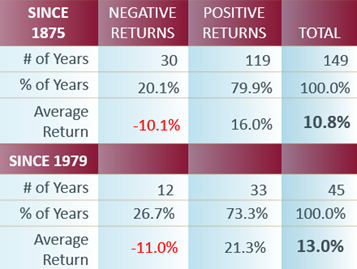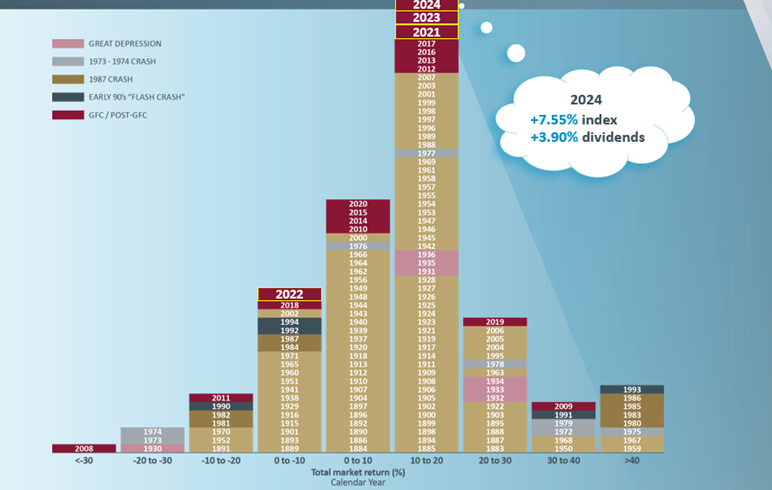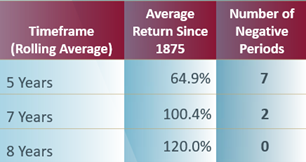The long term is Inevitable
Firstly, the short term is unknowable, but the long term is inevitable. The stock market has good years and bad, but over the long term there is only one trend and it is up. Despite this being so obvious, I continue to be astounded at how investors behave during ‘bad’ years.
Calendar Year 2024 marked the 149th year of trading on the Australian Stock Exchange. That enormous amount of data provides the clearest guide to anyone willing to learn. During this period, the market (dividends plus capital growth) has risen 119 years and declined 30 years. So 79.9% of the time, the market rises. One in five years on average, the market declines.
 Source: Katana Asset Management
Source: Katana Asset Management
When the market rises, it does so by an average of 16.0%, and when it declines the average is minus 10.1%. When combined, we see that over the past 149 years, the market has averaged a return of 10.8% per annum.
Since we have become more sophisticated and introduced the Accumulation Index in 1979, the data points to an even stronger outcome. Over the 45 years since 1979, the market has risen by an average of 13.0% per annum. And this is despite some large market dislocations, including the 1987 Stock market crash, the 1997 Asian Financial Crisis, the GFC and the fastest crash on record, Covid-19.
Volatility is the price you pay for a seat at the table
But of course in the short term – from year to year – markets are volatile.
We’ve all seen this distribution curve below – perhaps numerous times. But I suspect that many investors have failed to grasp the most important aspect.

Source: Katana Asset Management
And that put simply is that crashes are inevitable; be ready and don’t panic at the bottom (the only time to panic is at the top).
Case in point, there has only been one (calendar) year in the ASX’s 149 year history, where the market fell by 30% or more – 2008. But if you panicked and sold during that crash, you would have missed an extraordinary recovery. In 2009 the market was up by 39.6% and rose in 11 of the 14 years following the crash, including by 18.8% in 2012, 19.7% in 2013 and 24% in 2019.
One in 5 years you will wakeup and question why you invested in the stock market! Know thyself. Understand history. Forewarned is forearmed.
If there is a better table than this, send it to me…
To better understand how the market behaves over different timeframes, we can break the data into rolling periods. For example, a rolling 5 year period, is the average return over every 5 year period since 1875.
What this table demonstrates is rather extraordinary.
 Source: Katana Asset Management
Source: Katana Asset Management
If you were to invest your money in the ASX (index), turn off your screen, go away and come back in 5 years’ time, then on average you would have a 64.9% return, and there would have been only 7 occasions out of the 145 rolling 5 year periods where you would have a negative return.
If you were to invest your money in the ASX (index), turn off your screen, go away and come back in 7 years’ time, then on average you would have a 100.4% return, and there would have been only 2 occasions where you would have a negative return.
But even more remarkably, if you were to invest your money in the ASX (index), turn off your screen, go away and come back in 8 years’ time, then on average you would have a 120.0% return, and there would have been NO occasions on record where the dividends and capital growth would have been negative.
There is only one long term trend, and it is up.
Wait…here’s a better table!
 Source: Katana Asset Management
Source: Katana Asset Management
We’ve literally compiled hundreds of tables over the past 3 decades, and this is our best. There are 2 critical points.
Firstly, we see even more dramatically, the true power of compounding. Compounding for 10 years produces the equivalent of 17 one-year returns. Impressive. But compounding for 20 years produces the equivalent of an extraordinary 63 one-year returns!
And finally, the importance of generating an extra margin. As an example, the Katana Australian Equity Fund (KAEF) has generated close to an extra 2.7%+ per annum net of all fees for nearly 2 decades (note past performance is no guarantee of future performance). If we take a 2.7% per annum margin and compound it over 10, 15 and 20 years, then the effects are mind-boggling. Over 10 years, it is the equivalent of 24 one-year returns. Over 20 years, this generates the equivalent of 107 one-year returns. Difficult to believe, but true. Generating an extra 2.7% per annum (net) generates the equivalent of 107 one-year returns versus 63 one-year returns without it.
Romano Sala Tenna is Portfolio Manager at Katana Asset Management. This article is general information and does not consider the circumstances of any individual. Any person considering acting on information in this article should take financial advice.
Past performance is not a guarantee of future performance. Stock market returns are volatile, especially over the short term.